most cards shown in this page belong to the mid 18th century decks printed by
Nicolas Conver in Marseille, (marked NC) and by Ignaz Krebs in Freiburg (marked IK);
the faithful reprints are by Lo Scarabeo (Italy) and by Piatnik (Austria), respectively
All the subjects of the tarot of Marseille basically match the ones belonging to the
Pierpont-Morgan Visconti deck
(see
THE VISCONTI TAROTS), with
simplified illustrations due to the inevitable change of technique, from hand-painted illuminations to woodblock
prints, rather roughly engraved in some editions, later coloured by stencils.
Nevertheless, many among the allegories are absolutely similar, and also the ordering of the
22 trumps may have likely been in common with the early tarot, but only in Marseille's
pattern the ranking can be told without any doubt, thanks to the roman numeral on each card.
Two subjects, though, were given a different interpretation:
the Old Man (or
Time) became
the Hermit,
while
Lightning became
the House of God (known in English as
the Tower).
(left) the Old Man or Time (Pierpont-Morgan Visconti),
(center and right) the Hermit in Marseille's pattern (NC and IK) |
|
The personage of the ninth trump is a standing male figure of
mature age (as suggested by the beard and sometimes by grey hair), who wears a long cloak.
He was seen as a hermit, and given a lantern in one hand, held from the top,
a graphic corruption or an evolution of the old hourglass (held from its base), a symbol of time.
With his other hand he holds a walking stick or staff, not too different from the one found
in early representations.
In some editions the man's frock looks very similar to a monk's cowl,
plain and brown, with a hood; such detail was retained by the pattern known as Besançon tarot
or Swiss tarot (see page II).
|
This interpretation was not exclusive of Marseille's pattern: among the few examples of tarots from Ferrara (i.e. the eastern group, or Dummett's group B) are the so-called Dick sheets, uncut woodblock prints featuring some trumps, approximately dating back to year 1500; one of the subjects (picture on the right) is the Hermit, holding a lamp, as in the French fashion. But in older tarots from the north-east of Italy, such as the one named after Alessandro Sforza, duke of Pesaro in the mid 1400s, the same personage still held an hourglass; this testifies that the lantern was a real change, likely occurred sometime by the turn of the 16th century.
The rank number XI, seen on the printed card, is due to a different ordering of the trumps
in Ferrara's tarots, see page III, but since the name of the
subject is not shown, it would be difficult to guess whether early players called this a
"hermit" or an "old man".
|
|
the Hermit cards of B-group pattern:
tarot of Alessandro Sforza (c.1470, or earlier),
and the same subject from a Dick sheet (c.1500)
|
Lightning in the tarot of Charles VI and
the House of God (i.e. the Tower) by NC |
|
The House of God, i.e. the Tower, features a thunderbolt that strikes down from the top
right corner of the card, splitting a tall tower and causing two anonymous personages to be tumbled to
the ground. This illustration is consistent with the relevant fragment of the Cary sheet.
A connection with the biblical tale of Babylon's tower has been suggested
to explain this representation, which was originally called Lightning or
the Thunderbolt.
In any case, the original meaning of the subject remains substantially the same,
i.e. a warning or a punishment for man's pride, sent from the heavens.
We may well understand how the old subject was turned into this new shade of meaning by
considering the relevant illustration in the Tarot of Charles VI, where a square-shaped
tower is actually stricken by a thunderbolt. |
In the twelfth trump,
the Hanged Man, we see a linguistic evolution of an old
subject's name. In Marseille's pattern it looks similar to the one found in other previous tarots,
i.e. a young man tied by one foot to a rectangular scaffold, but the original
title of the trump was
the Traitor.
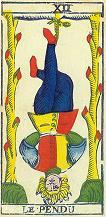
NC - the Hanged Man |
In some areas, traitors and debtors used to be hung by one leg in a rather uncomfortable attitude,
very similar to the one seen in this card: the young man tied to the scaffold may in fact
be the same traitor, although French players probably labelled the trump as the Hanged Man
because this form of punishment was unknown in France.
In fact, the peculiar attitude of this personage also caused problems in orienting the illustration:
in some editions the number XII appears reversed, i.e. IIX,
as if the card had to be looked at upside-down. This was particularly evident in the north
of France and in Belgium (see part 3).
|

NC - the Devil |
Trump number XV, the Devil, is another subject missing from
Milan's 15th century decks we know. However, since it is found in early tarots of the
other two groups, we may reasonably think that this already was a common feature before
Marseille's pattern was created. The latter features a winged and horned demon with female
breasts and a second face on its belly, symbolizing low instincts, an appetite for material
things. The creature is seen from the front, standing on a pedestal to which two smaller
horned figures are tied or chained. This way of representing the Devil is typical of
most varieties belonging to group C, but is also one of the few details not consistent
with the Cary sheet, in which the demon is shown sideways, picking up a human body with a
trident while others are already in his pannier. |
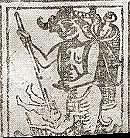
the Devil, fragment
from the Cary sheet |
The three astronomical subjects, the Star, the Moon and the Sun, all show distinctive
features in the lower half of the card, in a fashion similar to the same trumps
of the Cary sheet. In the first one, a naked kneeling female pours the content of two vessels
into a river. The second one has two dogs on the edge of a pond, whose
center is occupied by a lobster or cray-fish, while a sickle-shaped moon with a face sheds
its drop-shaped rays from above. A comparison with the Cary sheet's subject can be seen
in part 1. The cray-fish may be the corruption of a crab,
a reference to the zodiac constellation of the Cancer.
The third subject features two semi-naked children, maybe twins or brothers, under the rays
of the sun, which fall down again as drops. |
The last card of the series, the World, changed its look
quite radically. The traditional allegory of this trump used to be an ideal city, inscribed
within a circle and overlooked by heavenly personages, such as an archangel or cherubs;
in Marseille's pattern this was replaced by a female figure holding a short staff, in the
center of an almond-shaped wreath, while the corners are filled by the symbols of the four
evangelists: the angel for Matthew, the eagle for John, the bull for Luke and the lion for Mark, a scheme also known as the
Tetramorph. |
|
NC - the Star, the Moon and the Sun |
A few more trumps in Marseille's tarot developed peculiar details, although their subjects
did not really change.
the World, from the late 1400s (Cary-Yale
Visconti tarot, left) to Marseille's pattern (NC) |
|
For instance, in the Lovers card a third
elder figure is featured next to the young couple, whose purpose is apparently that of
officializing or blessing their wedlock, while Cupid points his love dart at them, from above. This trump was formerly called Love; due to the semantic change that took place in the tarot of Marseille, the abstract feeling turned into a more physical subject (two lovers, i.e. a man and a woman), although its symbolic meaning, and the way of graphically rendering it, remained almost the same. |
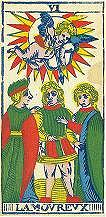
NC - the Lovers |
The Wheel of Fortune lost one of its original four personages, i.e. the one below the device
who, according to different early editions, is either kneeling on his fours (as in the Pierpont-Morgan
Visconti tarot), or clings to the wheel (as in the fragment of the Cary sheet, or in the
Tarot de Paris).
Furthermore, the remaining personages are featured as animals,
to remark man's imperfect nature through the ups and downs of fate: the ascending one is
a donkey, the descending figure is probably a dog, while a crowned lion on top holds a sword.
The original blindfolded female figure found in the aforesaid Visconti tarot in the center of the wheel,
an allegory of Fortune, was dropped. |
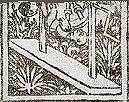
the Cary sheet's Wheel |
Curiously, in the fourteenth trump the female figure of Temperance grew wings on her back, but kept her usual
standing attitude, pouring water from one jug into another. None of the two other cardinal virtues,
Strength and Justice, acquired wings as the first one did (see also the Viéville's
tarot in part 3).
|
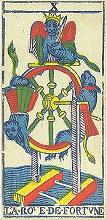
NC - the Wheel of Fortune |
|
ace of Cups from the Cary-Yale Visconti tarot (left)
and from Marseille's tarot (NC and IK) |
|
The suit cards of the deck provide a further confirmation of
the relation between Marseille's pattern and Milan's earliest tarots; the most evident detail
is the famous ace of Cups, whose look remained basically the same as the one found in the Cary-Yale Visconti deck (mid 14th century).
Conversely, a hand firmly grasping the suit sign was added to the aces of Batons
and Swords, as an additional decorative element, which had never appeared before. |
|
Also the use of curved Swords and straight Batons is consistent with the northern Italian
patterns, although these features are less specific, being shared by all three tarot groups.
Small indices in roman numerals were adopted for pip cards of the suits of Swords and Batons,
located on both sides of the illustration, whose double purpose may have likely been that of helping the early
French players, not accustomed to such complicated arrangements, in reading the card's value,
but also that of modern indices, i.e. to easily tell the cards while held in hand in fan
position, or simply overlapped.
Lastly, among the typical details of Marseille's tarot is the French royal device
(later on adopted by the Ile de France administrative district), featuring three fleur-de-lys, found on the
4 of Coins, which in some editions is repeated on other subjects, as well.
|
|
NC - 4 of Coins, ace of Swords and 10 of Batons; note the
three fleur-de-lys, i.e. the French royal device, on the first card |
GO TO
PART 1
THE TAROT OF MARSEILLE:
ORIGIN AND DEVELOPMENTS |
PART 3
OBSERVATIONS ABOUT SOME
FRAGMENTARY SUBJECTS OF THE CARY SHEET |
further reference to tarot decks can be found in Trionfi and in
The Hermitage
OTHER GALLERIES






















or back to

INTRODUCTION
AND HISTORY
|

MULTI-LANGUAGE
GLOSSARY |

THE FOOL &
THE JOKER |

INDEX
TABLE |

REGIONAL
GAMES |

PLAYING CARD
LINKS |